Perhaps the most effective way to scare consumers and regulatory agencies alike is to suggest that a certain product contains a ‘dangerous’ chemical. Even more effective? Have a scientist with four degrees from MIT — but none in food science or genetics — publish a study concluding that the food we eat every day contains formaldehyde.
Nobody wants to ingest harmful substances let alone feed them to our family, so the idea of an embalming fluid finding its way to our dinner plates sounds horrific. But that’s exactly what Dr. V.A. Shiva Ayyadurai claims.
Ayyadurai is certainly a smart and interesting person. While in high school in the early 1980s, he developed an electronic office messaging system that he dubbed EMAIL, which he copyrighted. He long claimed that he “invented” email, but that’s now widely dismissed as resume padding; we know that email took its first primitive steps in 1971, if not earlier. After the controversy unfolded, MIT disassociated itself from Ayyadurai’s EMAIL Lab and funding was dropped. MIT also revoked Ayyadurai’s contract to lecture in the bioengineering department.
Along the way, Ayyadurai received a degree in electrical engineering and computer science and later in biological engineering… He later secured a grant to study the integration of Siddha, India’s oldest system of traditional medicine with biology. Kind of woo woo. Last year, he married rabid anti-GMO activist Fran Drescher, better known as the actress who played The Nanny in the popular 1990s sitcom, in a spiritual ceremony.
Ayyadurai is now in the news after the publication earlier this month of a controversial paper,“Do GMOs Accumulate Formaldehyde and Disrupt Molecular Systems Equilibria? Systems Biology May Provide Answers.” It was published in Agricultural Sciences. If you’ve never heard of it, that’s because it’s a low-impact “pay-for-play,” journal. Ayyadurai’s paper shows that its editorial standards are less than stringent.
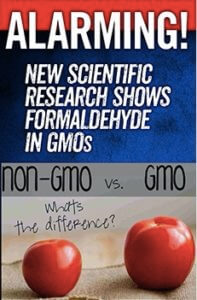
Within days of lead author Ayyadurai and co-author Prabhakar Deonikar publishing the study, dozens of anti-GMO organizations, from Organic Consumers Association to GMO Inside, were hyping the paper with scaremongering headlines such as “Formaldehyde in GMO Soy?” and “New Study Shows GMO Soy Accumulates Cancer Causing Chemical Formaldehyde” with alarmist graphics to accompany them.
GMO Free USA, an anti-GMO lobbying organization, released an infographic meme declaring “Formaldehyde is a known carcinogen. GMO soy is carcinogenic?”

Anti GMO activists are capitalizing on what’s known as “chemophobia”– irrational fear of chemicals (see book by GLP’s Jon Entine on the phenomenon, Scared to Death). Chemophobia is grounded in the simplistic, unscientific belief that chemicals are potentially dangerous simply because they are synthetic, while all things natural are chemical-free and therefore safe. So naturally, a scary-sounding chemical name can induce widespread public panic about a product or food.
The fact is that anything and everything is composed of chemicals, including all foods. A central tenet of toxicology, “the dose makes the poison” underscores the reality that everything from vitamins to Viagra can be toxic at certain levels. Take dihydrogen monoxide (DHMO), a colorless, odorless compound that causes death with inhalation, erodes metals, and is responsible for thousands of severe childhood burns every year, yet is found in almost all food and drink on the market. Pretty alarming right? But it’s a false alarm. DHMO is an unconventional term for H20, better known as water. A 1994 hoax used these scare tactics about good old water to demonstrate the need for critical thinking.
Objective vs. biased systems biology approach
A fact that likely flew under the radars of wary consumers reading the headlines following Ayyadurai’s publication? His research now celebrated by anti-GMO activists, with propaganda point work by the Fenton Communications, known for its work with anti-science activist groups, didn’t measure actual formaldehyde levels in soy. So how does a study conclude that there are dangerous levels of formaldehyde in a product without actually measuring levels of the chemical? The lay reader might gloss over the term “systems biology” in the paper’s title. Basically, the research didn’t involve testing levels in actual plants, but used data plugged into a computer algorithm to predict the presence of two chemicals found naturally in crops and food: Formaldehyde and glutathione.
In other words, it was a computer modeling study, so it “measured” what the researchers inputted. That works when the data is robust and independently verified. Otherwise the old adage applies: junk in, junk out. Systems biology can be a useful approach if employed properly, and that’s a big “if”. As explained in a recent post by Kevin Folta, a geneticist and head of the horticultural department at the University of Florida, the results from such methodology are only reliable if the data were derived from previous published work analyzed in silico, meaning performed on a computer model rather than in a living organism (in vivo) or in a test tube or petri dish (in vitro), to generate new hypotheses.
In this case, it is unclear what data were used, and where Ayyadurai sourced them. “Online databases including PuMed and Google Scholar were searched,” the paper indicated. Though Ayyadurai asserts that he aggregated data from over six thousand studies, it’s unclear what data, in particular, were plugged in to Ayyadurai’s algorithms. As Folta wrote,
“If you developed a computer program that integrated internet data to predict the location of Munich, and the program told you it was squarely in the Gulf of Mexico, right off Florida, it does not mean that Munich is in the Gulf of Mexico, right off of Florida. It means that your program, your assumptions, or your input data are wrong. These things are quite testable.”
Ayyadurai is now on a Fenton organized US tour, funded by a mystery organization, GMO Free News, a virtual organization with no clear structure or leadership but believed to be bank rolled by Dr. Bronner’s Magic Soaps, a key organic industry funder of the anti-GMO and mandatory labelling movements. The “GMO Free News” hosts are Kathleen Hallal, affiliated with Mom’s Across America, and Rachel Linden, linked to GMO-Free USA (an affiliate of MAA and linked to Henry Rowland’s Sustainable Pulse and GMO-Free Global campaign). In his speech at the National Press Club in Washington D.C. on July 14, Ayyadurai stated, “What we discovered was, there were two important criteria, at least from the study so far, that are very different in GMOs and non-GMOs. Particularly two chemicals, one is formaldehyde, and one is glutathione.”
Ayyadurai explained, correctly, that formaldehyde is naturally created in all plants. “The normal plant has a beautiful way of detoxifying it, it’s called formaldehyde detoxification. So in the normal case plants create formaldehyde during the process of photosynthesis, etcetera, other processes. And they also clear it.” He also explained that glutathione is an important and necessary antioxidant, helping plants and animals remove toxins and waste from their cells.
This is where Ayyadurai’s commitment to scientific objectivity apparently ended and his ideological convictions began to emerge. Genetic modification has “fundamentally modified the metabolic system of the soy,” he told reporters at the conference, a claim unsupported by either his research or any independent research. He presented no data. He went on to declare that “natural,” “normal” soy has a “beautiful way of detoxifying [formaldehyde]” while the “GMO of soy” as he called it, accumulates the chemical, presumably until it reaches to harmful levels.
Though metabolic processes of soy and other plants use myriad naturally-occurring chemicals, formaldehyde is among the big bad substances that would undoubtedly frighten the public. Kevin Folta wrote:
“If you wanted to design an experimental outcome that was scare parents and influence political decisions, it might be effective to find something dangerous in their food. What plant metabolite would you suggest? Of the tens of thousands that occur in plants, nobody is going to freak out if you over-produce eugenol (the stuff that smells like clove oil) or ascorbic acid (vitamin C). You need something scary, something evil — formaldehyde!”
The idea of even pursuing a computer model for formaldehyde in GE versus non-GE varieties is an example of confirmation bias in research design. Publishing the skewed results, à la locating Munich in the Gulf of Mexico, demonstrates that something fishy is afoot, to put it mildly.
Though the premise of the experiment itself is undermined by the flawed assumption that there are material differences between GE and no GE foods, and scientists are stepping up to respond to Ayyadurai’s misinformation campaign, much of the damage to public discourse is already done. The scare memes and articles have spread quickly across social media platforms; one article went so far as to claim that mothers are unknowingly poisoning their children.
Peer-reviewed publication plays on public panic
The EPA, along with global regulatory agencies, have concluded that formaldehyde poses no risk to humans via low-level ingestion in food but could pose harm at high exposure levels if inhaled over unusually prolonged periods of time. There is no evidence that GMO soy or any other genetically engineered plant accumulates formaldehyde at a higher level than non-GE counterparts–and the amount that does accumulate is thousands of times below levels that could conceivably pose any health risks. But that hasn’t stopped the authors from making exaggerated claims of the unique dangers of GMOs at one campaign stop after another.
In a live online Q&A hosted by GMO Free News on July 28, Ayyadurai asked rhetorically, “The real issue comes down to non-GMO vs. GMO, what’s the difference? What’s the difference between David Banner and the Hulk?” (It’s a silly analogy to the comic book legend, but David Banner was transformed into the Hulk when he was exposed to an unusually high dose of gamma radiation.)
The paper claims that the concept of “substantial equivalence,” the federal guidance that dictates that a new food should be regulated as all other foods in matters of safety and nutrition if equivalent in composition to existing products, is flawed. U.S. Food and Drug Administration regulators have used the concept to determine that genetically-engineered products are inherently no different than their non GE counterparts, and thus don’t require federally-mandated labeling. That’s in line with the findings of every major scientific oversight agency in the world, which have issued a policy statement concluding that genetically engineered foods are as safe or safer than organic or other conventional alternatives, including the World Health Organization and the American Association for the Advancement of Science.
No, genetically modified foods are not comparable to the “Hulk”, David Banner’s mutant alter-ego. The term “GMO” refers to a set of processes collectively known as genetic modification, and not an end product. A GMO is not an ingredient that can be scooped into a jar; it’s a set of breeding techniques. The term GMO — Genetically Modified Organism — is itself fundamentally misleading. Many breeding techniques involve radically modifying the apparent “natural” state of a plant in a laboratory, such as altering a plant’s genome using chemicals or radiation — mutagenesis — and yet the food products that result from these lab manipulations can be certified and sold as organic and “non-GMO”. So why should molecular genetic engineering, the most precise way to modify a crop for a desired trait, and altering only one or a few genes versus thousands, be the only technique Ayyadurai throws under the substantial equivalence bus?
The answer appears to be ideology. Shiva Ayyadurai helped launch and serves on the board of an organization that promotes organic, non-GMO food while Fran Drescher is a rabid anti-GMO activist, who is a constant presence on social media tweeting about the dangers of modern science. And neither one of them has attempted to hide his or her bias.
Mr. and Mrs. Nanny spread their message on social media
The paper itself and online rantings from Ayyadurai and his wife Fran Drescher, who has over five hundred thousand social media followers between Twitter and Facebook, highlight the pair’s anti-ag biotech bias. For example, Ayyadurai has been flogging the narrative that genetically engineered soy has elevated formaldehyde levels:
The impact of the unscientific fear mongering is hard to contain once it’s infected the public discussion. Though his work is skewed, blogs and some articles touting the results as fact have taken hold in the Internet. Ayyadurai’s propaganda study comes at a fortuitous time for the anti-GMO movement. It comes in the wake of a July 2 White House announcement outlining its intentions to overhaul safety and transparency of biotechnology regulation. Activists are already latching on to this study in an attempt to influence the policy debate.
In an apparent attempt to keep the momentum going, Ayyadurai has taken to Twitter, re-tweeting anti-GMO links, and demanding a debate with top Monsanto scientists.
Numerous scientists, led by Folta, have attempted to reach out to Ayyadurai to discuss his methodology and propose rigorous testing of his thesis, but all they’ve gotten so far is crickets and censorship. Ayyadurai and anti-GMO social media admins have been deleting challenging Facebook comments, like this one from independent scientist Dr. Mary Mangan, within minutes of posting:
After repeatedly calling anyone who dared to challenge her husband’s findings Monsanto shills, Drescher, apparently speaking on behalf of her husband, called for open and independent testing of formaldehyde and glutathione levels in GM samples. Yes, that could resolve this souped up controversy.
But when an actual response came agreeing to take up Drescher’s challenge, her offer was withdrawn. Kevin Folta answered the call to #ShowUporShutUp by issuing The GMO Formaldehyde Challenge, in which he invited Ayyadurai to participate in university based testing of transgenic corn and soy samples, with analysis by an independent lab. Referencing Drescher’s hashtag, Folta wrote:
Let’s talk about #ShowUporShutUp. It is really simple to measure formaldehyde levels quantitatively in plant extracts. I’ve started to build a collection of materials to actually do the test. I’ll have probably a dozen soy/corn samples on hand in a week or so, both transgenic (GMO) and corresponding isolines. This way we can test the systems biology-driven hypothesis, potentially validating Ayyadurai’s findings. I was hoping to just do this on my own to not waste lots of time. However, transparency and wider involvement would be a good thing. Therefore, I’ve invited Dr. Ayyadurai via Twitter to come to [University of Florida] and do the extractions and analysis with me.
Ayyadurai has side stepped the invitation. On Tuesday, he said he would only agree to testing if there were new across-the-board standards — that he personally set up. He modestly proposed that he is willing to meet with “big agribusiness” himself to draw up these new standards. Why would Ayyadurai need to be involved in setting up “new” standards? Because, he said, only he has the expertise to establish the evaluation protocol, not the geneticists and scientists who have been working in the field for decades.
“The biologists that are approaching this have no knowledge of modern biology, and that biology is used in a lot of the [pro-GE] articles we’re seeing,” he stated. Explaining that systems biology, which he characterized as taking into account all of the complex metabolic interactions in a living cell, integrates and aggregates big data from a vast number of experiments, he continued, “These people don’t really know what biology is. Systems biology basically says you aggregate experiments.”
To paint all geneticists and biotechnology scientists with a “they don’t know what biology is” brush is simultaneously arrogant and brilliant. It casts Ayyadurai as the lone independent expert in this area of scientific inquiry. The crucial problem with his repeated assertions that scientists and science writers simply don’t understand systems biology, which he asserts is the modern biology of the post-genomic era, is that it’s not true.
Ayyadurai’s claims will be evaluated with or without his participation, Kevin Folta has told the Genetic Literacy Project. Folta expects to have samples of corn and soy within a week, and a full experimental plan is expected to be posted online. Results showing comparative levels of formaldehyde and glutathione in both GE and non GE varieties should be available shortly thereafter. The formaldehyde measurements will be contracted to an independent core facility and glutathione will be measured by either high school or undergraduate students. Folta, a public scientist who says he will pay for much of the testing himself, has been transparent on social media about the experiment, tweeting to followers after arranging for independent lab testing.
Ayyadurai’s refusal to participate in designing and performing such experiments is baffling. Why call for verification of his research predictions and then balk at following through? Will real science confirm substantial equivalence between GE and non GE plants?
The answers are forthcoming. Stay tuned.
Kavin Senapathy is a contributor at Genetic Literacy Project, Skepchick, Grounded Parents, and other sites. She is a mother of two, science popularizer, and freelance writer in Madison, WI. Contact and follow Kavin at fb.com/ksenapathy and Twitter @ksenapathy. Republished from Genetic Literacy Project. Read the original here.



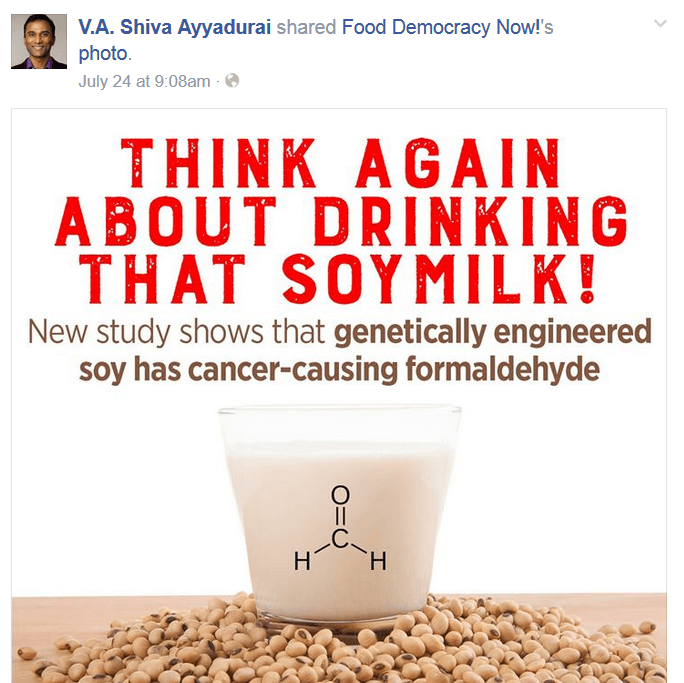

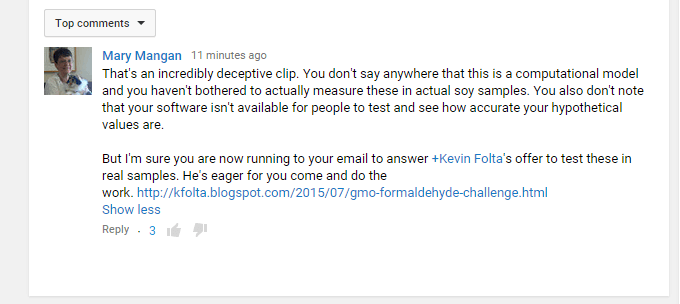
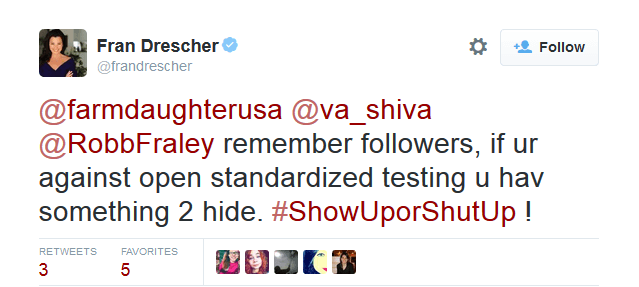
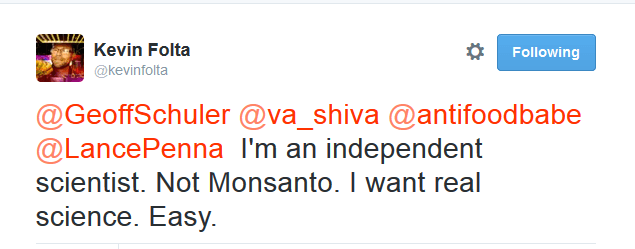


Comments